Nemanjić dynasty
The Nemanjić (Serbian Cyrillic: Немањић, pl. Nemanjići / Немањићи, pronounced [nɛ̌maɲitɕ]) was the most prominent dynasty of Serbia in the Middle Ages. The princely, royal, and imperial house produced twelve Serbian monarchs between 1166 and 1371.
| Nemanjić Немањић | |
|---|---|
| Parent house | Vukanović dynasty |
| Country | Serbia: |
| Founded | 1166 |
| Founder | Stefan Nemanja |
| Final ruler | Stefan Uroš V of Serbia |
| Titles |
|
| Estate(s) | Rascia, Doclea-Zeta, Travunia, Dalmatia and Zachlumia |
| Dissolution | after 1422 (see fall of the Serbian Empire) |
| Cadet branches |
|

Its progenitor was Stefan Nemanja, scion of a cadet branch of the Vukanović dynasty (1101–1166). After Nemanja, all monarchs used Stefan as a personal name, or a ruler's name, a tradition adopted for the royal pretensions.[A] The monarchs began as Grand Princes, and with the crowning of Stefan Nemanjić in 1217, the realm was promoted to a Kingdom, and the Serbian Orthodox Church was established in 1219. In 1346, Stefan Dušan was crowned Emperor of the Serbs and Greeks, and the Archbishopric of Serbia was elevated to a Patriarchate.[1]
The dynasty's rule in Serbia ended in 1371, with the death of childless Uroš the Weak (r. 1355–1371). This led to the fall of the Serbian Empire. Provincial lords took control of their provinces. The last remaining members of the House of Nemanjić were John Uroš, ruler of Thessaly, titular emperor of the Serbians and Greeks, who died c. 1422-23, and his younger brother, Stefan Uroš, ruler of Pharsalos. Nemanjić descent survived only through maternal lines in several Serbian houses.[2]
Background
The Serbs, as Slavs in the vicinity of the Byzantine Empire, lived in so-called Sklavinia ("Slav lands"), territories initially out of Byzantine control and independent.[3] In the 8th century, the Vlastimirović Dynasty established the Serbian Principality.
In 822, Serbia "stretched over the greater part of Dalmatia",[3] and Christianity was adopted as state-religion in circa 870.[3]
In the mid-10th century the state had emerged into a tribal confederation that stretched to the shores of the Adriatic Sea by the Neretva, the Sava, the Morava, and Skadar.[3]
The state disintegrated after the death of the last known Vlastimirid ruler – the Byzantines annexed the region and held it for a century, until 1040 when the Serbs under the Vojislavljević Dynasty revolted in Duklja (Pomorje).[3] In 1091, the Vukanović Dynasty established the Serbian Grand Principality, based in Rascia (Zagorje).[3] The two halves were reunited in 1142.[3]
In 1166, Stefan Nemanja took the throne, marking the beginning of Serbia, henceforth under the rule of the Nemanjići (Vukanović branch).[3]
Serbia under the Nemanjić dynasty

Serbia reached its height of power during the Nemanjić dynasty. The Serbian Kingdom was proclaimed in 1217, leading to the establishment of the Serbian Orthodox Church in 1219. In the same year Saint Sava published the first constitution in Serbia: St. Sava's Nomocanon.[4]
Tsar Stefan Dušan proclaimed the Serbian Empire in 1346. During Dušan's rule, Serbia reached its territorial, political, and economical peak,[5][6] proclaiming itself as the successor of the Byzantine Empire, and was the most powerful Balkan state of that time. Dušan enacted an extensive constitution, known as Dušan's Code, opened new trade routes, and strengthened the state's economy. The Serbian identity has been profoundly shaped by the rule of this dynasty and its accomplishments,[7] and the Serbian Orthodox Church has assumed the role of the national spiritual guardian.
Stefan Dušan attempted to organize a Crusade with the Pope against the threatening Turks, but he died suddenly in December 1355 at the age 47.[8] He was succeeded by his son Uroš, called the Weak, a term that might also apply to the state of the empire, which slowly slid into a feudal anarchy.[9] This was a period marked by the rise of a new threat: the Ottoman Turk sultanate, which spread from Asia to Europe conquering Byzantium and then the other states in the Balkans.
Members
Monarchs
The Nemanjić dynasty ruled the Serb lands between ca. 1166 up to 1371.
| Picture | TitleName | Reign | Notes | ||||||
|---|---|---|---|---|---|---|---|---|---|
 | Grand Prince Stefan Nemanja | 1166–1196 | Nemanja is the eponymous founder of the Nemanjić dynasty. He re-established control over the neighbouring territories, including Duklja, Hum and Travunia. In his last years, he joined his son Sava and took monastic vows, later recognized as Saint Symeon after numerous alleged miracles following his death. Note: Duklja, Zahumlje and Travunija is reconquered, Nemanja is proclaimed "Grand Prince of All Serbia" | ||||||
 | Grand Prince Vukan | 1202–1204 | Eldest son of Stefan Nemanja. He held the appanage of "Duklja, Dalmatia (Zahumlje), Travunija, Toplica and Hvosno" as Grand Prince, by 1190. He was the initial heir presumptive, but his father chose Stefan instead upon the abdication in 1166. With the death of Nemanja, Vukan started plotting against his brother. He found help in Hungary, and together they forced Stefan to flee to Bulgaria. He ruled as a Hungarian vassal, evident in Emeric I's title "King of Serbia". He left the throne in 1204, and continued to rule his appanage, he was later pardoned by the third brother Saint Sava. | ||||||
 | King Stefan the First-Crowned | 1196–1202 1204–1228 | Second son of Stefan Nemanja. He inherited the title of Grand Prince in 1196 when his father retired as a monk. His reign began with a struggle against his brother Vukan, who expelled Stefan to Bulgaria. Kaloyan gave him an army of Cumans in exchange for eastern territories. The crisis ended when Sava negotiated a peace between the brothers and Stefan's power was cemented. He was crowned King in 1217, and then Sava gains autocephaly, becoming the first Archbishop of Serbs in 1219, thus Serbia retained full independence. | ||||||
 | King Stefan Radoslav | 1228–1233 | Son of Stefan the First-crowned. He ruled Zahumlje during the reign of his father, and also held a governor status of Zeta. He was the co-founder of the Žiča monastery with his father, who would abdicate in 1227 due to illness, taking monastic vows. Radoslav was crowned by his uncle Sava, the Archbishop of Serbia. His marriage to Anna Doukaina Angelina would prove unpopular as she undermined his authority, he lost the loyalty of the people and in 1233 a revolt against them prompted the couple to flee to Dubrovnik.[10] | ||||||
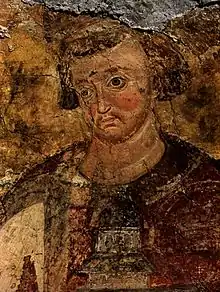 | King Stefan Vladislav | 1233–1243 | Son of Stefan the First-crowned. He succeeded his brother Radoslav in 1233 and ruled for 10 years, before being overthrown by his younger brother Uroš. He continued to rule Zeta. The first known flag design of Serbia was found in his treasury.[11] | ||||||
 | King Stefan Uroš I | 1243–1276 | Son of Stefan the First-crowned. He succeeded his brother Vladislav. He boosted trade with Dubrovnik and Kotor, marking a beginning of economic prosperity. In 1253 a war was fought against Dubrovnik, peace was signed in 1254, and in the 1260s a second war begun that ended in 1268. Uroš immediately turned towards Hungary, successfully taking Mačva, he was however captured and peace was ensured between the two Kings through marriage of Dragutin and Catherine, the daughter of Stephen V of Hungary. His oldest son Dragutin would have succeeded his rule, but Uroš favored Stefan Milutin, the younger son, as successor. He was overthrown by Stefan Dragutin in 1276.[12] | ||||||
 | King Stefan Dragutin | 1276–1282 1282–1316 | Son of Stefan Uroš I. He overthrew his father with help from the Hungarian royalty (through his marriage to Catherine of Hungary) after the Battle of Gacko. He was injured in 1282, and gave the supreme rule to his younger brother Milutin, but continued to rule what would later become the Kingdom of Srem with the capital at Belgrade. Milutin boosted relations with the Byzantine Emperor, and refused to give the rule to Vladislav II (Dragutin's son), causing a split of the Kingdom. Dragutin continued to rule the northern frontier in Hungarian alliance, but in the last years re-connected with Serbia, acting as a vassal.[13] | ||||||
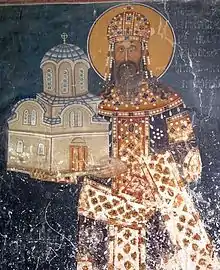 | King Stefan Milutin | 1282–1321 | Son of Stefan Uroš I. He succeeded his brother Dragutin. Upon his accession, he immediately turned towards Macedonia, conquering the northern part with Skoplje, which became his capital. He continued deep into Bulgarian lands, taking northern Albania and as far as Kavala. He also took Bulgarian Vidin, and later Durres. He was in a succession war with Dragutin after peace was signed with the Byzantines in 1299. Milutin aids the Byzantines against the Ottoman Turks at the Battle of Gallipoli, which ended in a victory. When Dragutin died he put most of his lands with Belgrade under his rule, in the same year his son Stefan Dečanski tried to overthrow him, resulting in him being exiled to Constantinople. In 1319 the Hungarians took all of Dragutin's lands but Braničevo.
| ||||||
 | King Stefan Konstantin | 1321–1322 | Younger son of Stefan Milutin, defeated in 1322 by his older brother, Stefan Dečanski. | ||||||
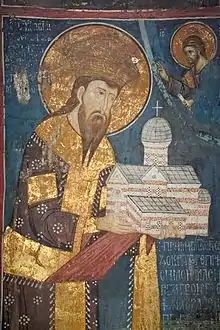 | King Stefan Dečanski of Dečani | 1322–1331 | Older brother of Stefan Konstantin. | ||||||
 | Emperor ↑King Stefan Dušan the Mighty | 1331–1355 | Son of Stefan Dečanski. He was a very skilled military leader, and defeated Bosnia and Bulgaria at the age of 20. As his father was not an able conqueror, Dušan removed him from the throne. Dušan doubled the size of the realm, taking Byzantine lands as far as the Peloponnese. He was crowned Emperor in 1346. The Serbian Empire flourished, and he enacted the constitution - Dušan's Code in 1349. | ||||||
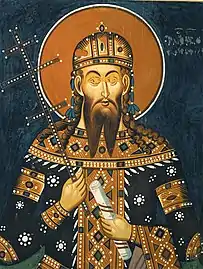 | Emperor Stefan Uroš V the Weak | 1355–1371 | Son of Stefan Dušan, crowned King of Rascia (1346–1355), succeeds as Emperor after the death of Dušan in 1355. His epithet was given due to his "weak rule".
|
Others
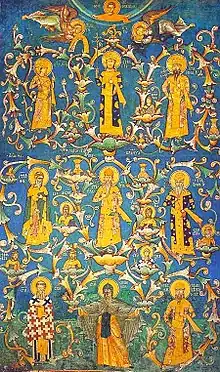
- Đorđe Nemanjić (1208–1243), King (titular) of Zeta
- Stefan Vladislav II, King of Syrmia, (r. 1321–1325)
Family tree
In popular culture
- 1875 historical three-tome novel "Car Dušan" by Dr Vladan Đorđević tells the story of Emperor Dušan.[14]
- 1987 historical novel "Stefan Dušan" by Slavomir Nastasijević is another story of Emperor Dušan.[15]
- 2002 historical novel "Dušan Silni" ("Dušan the Great") by Mile Kordić.[16]
- 2012 novel "Izvori - Roman o Nemanji i Svetom Savi" ("The Wellsprings - The story of Nemanja and Saint Sava") by Milan Miletić depicts Stefan Nemanja and his son, Saint Sava.[17]
- 2015 novel "Gora Preobraženja" by Ljiljana Habjanović Đurović tells the story of Saint Sava.[18]
- 2017 TV series "Nemanjići - rađanje kraljevine" (Nemanjić Dynasty: The Birth Of The Kingdom) portrays the rule of King Stefan the First-Crowned, the first King of Serbia.[19][20]
Notes
- ^ Name: The name Stefan in Serbian is derived from Greek Stephanos (Στέφανος, tr. Stéphanos), meaning "crown". All the rulers from family Nemanjić had one, or more other names (Nemanja, Uroš, ...) with the comon name Stefan. That is the main reason why some Serbian historians write, in recent works, that the name Stefan was not personal, but only a common one, or a ruler's name among the rulers from the Nemanjić family.[21]
See also
| Wikimedia Commons has media related to Nemanjić dynasty. |
References
- Fine 1994, p. 309.
- Beckwith, John; Krautheimer, Richard; Ćurčić, Slobodan (1986). Early Christian and Byzantine Art. ISBN 0300052960.
- Ćirković 2004.
- Ćirković 2004, p. 28, 40-46.
- "Brief History Of Serbia | dr Tijana Prodanovic". Retrieved 2019-10-29.
- USA, IBP. Serbia Country Study Guide Volume 1 Strategic Information and Developments. Lulu.com. ISBN 9781438758039.
- Degordian (http://www.degordian.com). "ISTORIJSKE OSNOVE SRPSKE POLITIČKE MISLI". Institut za političke studije. Retrieved 2019-12-12.
- Christian (2018-02-20). "Tsar Stefan Dusan and The Serbian Empire". About History. Retrieved 2019-10-29.
- Venning, Timothy; Frankopan, Peter (2015-05-01). A Chronology of the Crusades. Routledge. ISBN 9781317496434.
- Ćirković 2004, p. 38, 44, 46.
- Ćirković 2004, p. 38, 46, 58.
- Ćirković 2004, p. 47-49, 55.
- Ćirković 2004, p. 48-52, 62.
- Talija Izdavaštvo, accessed on 15-Apr-17, http://www.talijaizdavastvo.rs/korpa/knjige/34-dr-vladan-dordevic-trilogija-car-dusan.html
- Delfi.rs, accessed on 15-Apr-17, http://www.delfi.rs/knjige/49995_stefan_dusan_knjiga_delfi_knjizare.html
- Knjižare Vulkan, accessed on 16-Apr-17, https://www.knjizare-vulkan.rs/knjige/dusan-silni-mile-kordic-isbn-9788683583270%5B%5D
- Svetosavlj.org, accessed on 16-Apr-17, https://svetosavlje.org/izvori-roman-o-nemanji-i-svetom-savi/9/
- Story.rs, accessed on 15-Apr-17, http://www.story.rs/zabava/desavanja/57888/roman-o-svetom-savi-gora-preobrazenja-ljiljane-habjanovic-djurovic-na-beogradskom-sajmu-knjiga
- Nedeljnik.rs, accessed on 15-Apr-17, http://www.nedeljnik.rs/magazin/portalnews/vojin-cetkovic-o-seriji-nemanjici-pitace-se-neki-zasto-su-nasi-kraljevi-jeli-zlatnim-viljuskama-i-kasikama/ Archived 2017-11-12 at the Wayback Machine
- Blic Online, accessed on 15-Apr-17, http://www.blic.rs/zabava/vesti/blic-na-snimanju-nemanjica-vojin-cetkovic-za-ovu-ulogu-sam-se-spremao-ceo-zivot-video/hgzs8rb
- Logos 2017, p. 127-133.
Sources
- Bataković, Dušan T., ed. (2005). Histoire du peuple serbe [History of the Serbian People] (in French). Lausanne: L’Age d’Homme. ISBN 9782825119587.
- Ćirković, Sima (2004). The Serbs. Malden: Blackwell Publishing. ISBN 9781405142915.
- Curta, Florin (2006). Southeastern Europe in the Middle Ages, 500–1250. Cambridge: Cambridge University Press.
- Dvornik, Francis (1962). The Slavs in European History and Civilization. New Brunswick: Rutgers University Press.
- Fine, John V. A. Jr. (1991) [1983]. The Early Medieval Balkans: A Critical Survey from the Sixth to the Late Twelfth Century. Ann Arbor, Michigan: University of Michigan Press. ISBN 0-472-08149-7.
- Fine, John Van Antwerp (1994) [1987]. The Late Medieval Balkans: A Critical Survey from the Late Twelfth Century to the Ottoman Conquest. Ann Arbor, Michigan: University of Michigan Press. ISBN 0-472-08260-4.
- Gavrilović, Zaga (2001). Studies in Byzantine and Serbian Medieval Art. London: The Pindar Press. ISBN 9781899828340.
- Ivić, Pavle, ed. (1995). The History of Serbian Culture. Edgware: Porthill Publishers. ISBN 9781870732314.
- Jireček, Constantin (1911). Geschichte der Serben. 1. Gotha: Perthes.
- Jireček, Constantin (1918). Geschichte der Serben. 2. Gotha: Perthes. (Nachdruck Amsterdam: Hakkert, 1967)
- Krstić, Aleksandar R. (2016). "The Rival and the Vassal of Charles Robert of Anjou: King Vladislav II Nemanjić". Banatica. 26 (2): 33–51.
- McDaniel, Gordon L. (1984). "On Hungarian-Serbian Relations in the Thirteenth Century: John Angelos and Queen Jelena" (PDF). Ungarn-Jahrbuch. 12 (1982-1983): München, 1984: 43–50.
- Nicol, Donald M. (1993) [1972]. The Last Centuries of Byzantium, 1261-1453. Cambridge: Cambridge University Press. ISBN 9780521439916.
- Obolensky, Dimitri (1974) [1971]. The Byzantine Commonwealth: Eastern Europe, 500-1453. London: Cardinal. ISBN 9780351176449.
- Orbini, Mauro (1601). Il Regno de gli Slavi hoggi corrottamente detti Schiavoni. Pesaro: Apresso Girolamo Concordia.
- Орбин, Мавро (1968). Краљевство Словена. Београд: Српска књижевна задруга.
- Ostrogorsky, George (1956). History of the Byzantine State. Oxford: Basil Blackwell.
- Popović, Svetlana (2002). "The Serbian Episcopal sees in the thirteenth century". Старинар (51: 2001): 171–184.
- Samardžić, Radovan; Duškov, Milan, eds. (1993). Serbs in European Civilization. Belgrade: Nova, Serbian Academy of Sciences and Arts, Institute for Balkan Studies. ISBN 9788675830153.
- Sedlar, Jean W. (1994). East Central Europe in the Middle Ages, 1000-1500. Seattle: University of Washington Press. ISBN 9780295800646.
- Soulis, George Christos (1984). The Serbs and Byzantium during the reign of Tsar Stephen Dušan (1331-1355) and his successors. Washington: Dumbarton Oaks Library and Collection. ISBN 9780884021377.
- Stanković, Vlada, ed. (2016). The Balkans and the Byzantine World before and after the Captures of Constantinople, 1204 and 1453. Lanham, Maryland: Lexington Books. ISBN 9781498513265.
- Stephenson, Paul (2000). Byzantium's Balkan Frontier: A Political Study of the Northern Balkans, 900-1204. Cambridge University Press. ISBN 9780521770170.
- Logos, Aleksandar A. (2017). Istorija Srba I (PDF). Beograd. ISBN 978-86-85117-37-4. (in Serbian)
External links
- Nemanjić dynasty dinastija-nemanjic.weebly.com (in Serbian)
- Serbian Medieval History www.blagofund.org